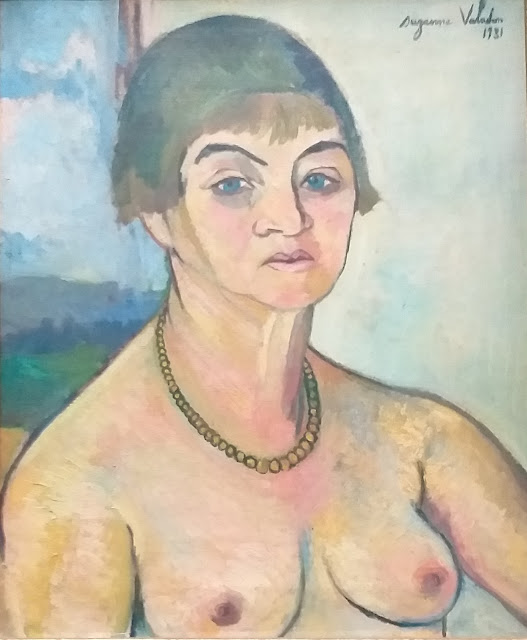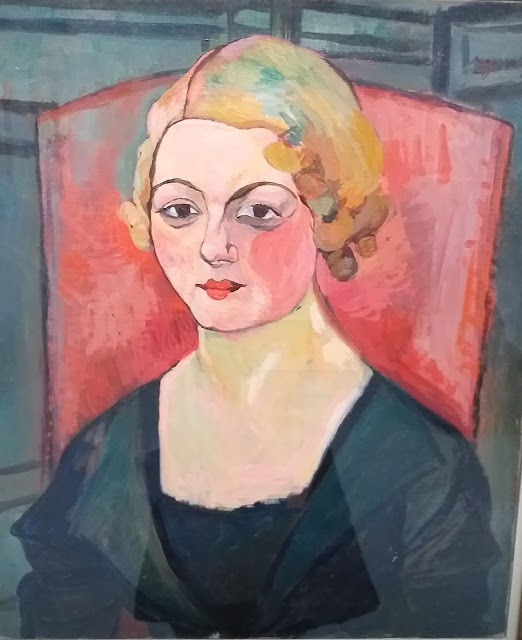 |
| Femmes aux bas blancs (Woman with white stockings) 1924 Musée des Beaux Arts, Nancy |
The artist Suzanne Valadon was fairly well known during her day, but her life story and association with several famous painters as model or lover has taken prominence nowadays and her art is a little neglected. The Pompidou exhibition displays various aspects of her work, from portraits, still lifes and landscapes to numerous nudes. Valadon's paintings reflect the influence of Cézanne and Gauguin, but her signature firm lines show how important drawing was to her. Her pastel self portrait aged eighteen is 'fauvist' before the term was invented:
 |
| Self portrait, 1883 pencil, charcoal and pastel on paper Centre Pompidou |
Valadon brings out bright colour contrasts in the skin tones of her nudes:
 |
| Les Baigneuses (The bathers) 1923 Musée d'Arts de Nantes |
She used as her artist's name 'Suzanne' - the nickname given to her by Toulouse Lautrec. He jokingly referred to her as Suzanne among the old men, referring to the Bible story, because she posed for certain rather aged painters, especially Puvis de Chavannes (1824-1898). Suzanne Valadon's life story is quite remarkable. Marie-Clėmentine, her real first name, was born in 1865- the year after Toulouse Lautrec. They were neighbours in Montmartre and lovers for about four years. He showed her work to Degas, who recognized her talent and taught her soft-ground engraving. She perhaps saw in Degas a father figure; they were friends until his death in 1917. Her adopted name as a model was 'Maria'. Degas' nickname for her was 'terrible Maria' (formidable Maria). Degas owned 17 drawings by her; he never used her as a model.
Renoir did however- he portrayed her in his famous 'Dance in the town' in the Musée d'Orsay and also in the following study which Orsay has loaned to the exhibition:
 |
| Pierre Auguste Renoir: La Toilette: Femme se peignant (woman combing her hair) 1907-8 Musée d'Orsay |
Valadon's self portraits are realistic to the point of harshness, unlike Renoir's softer style, and have a post-Impressionist vigour. Her strong colours are often outlined with a firm line.
This is her self portrait of 1916:
An anonymous photo in the exhibition shows her, aged 61:
 |
| Anonymous photo of Suzanne Valadon in 1926, aged 61 |
A later self portrait is an uncompromising study in colour and form, done when she was 66 years old:
 |
| Autoportrait aux seins nus (Self portrait with bare breasts) 1931 Private Collection |
Starting her life as acrobat, then artists' model, she did not follow an academic training, but had always loved drawing. She learnt from the artists for whom she posed. Eccentric composer Eric Satie fell madly in love with her, but the relationship only lasted five months. She left us a colourful portrait of Satie which lives in the Pompidou Centre:
 |
| Portrait d'Erik Satie 1892-3 Centre Pompidou |
In 1895 her marriage to stockbroker Paul Mousis provided a comfortable life for herself, her illegitimate son Maurice and her mother, while Suzanne painted. Her bold lines and strong colours are remarkable in the following portrait of a young girl drying herself off after bathing while a woman behind dries off the bath:
.jpg) |
| Jeune fille au bain (Young girl bathing) 1919 Weisman and Michel Collection |
Maurice, her son born in 1882, had been recognized as legitimate by Miquel Utrillo, a Spanish painter, although it's not sure he really was the father. Maurice Utrillo was to become the famous painter of Montmartre. His fame outshone his mother's. Suzanne eventually fell in love with an electrician friend of her son's, André Utter, over twenty years her junior and the three of them were known in Montmartre as the 'infernal trio'. Here is a family portrait, with her melancholic looking son Maurice at the front and mother and lover behind her:
 |
| Portrait de famille (Family portrait) 1912 Centre Pompidou |
She was the first woman to paint a large-size male nude:
 |
| Adam and Eve 1909 Centre Pompidou |
The frontal pose (using herself and lover André Utter as models) is quite audacious. She gives us a joyful version of Adam and Eve. Adam's fig leaf garland is thought to have been added later so that she may exhibit the work at the Salon des Indépendents in 1920!
While she taught him how to paint, her future husband André provided a good model for Suzanne:
 |
| André Utter nude, back view circa 1909 Pencil on paper. Private Collection |
She had earlier exhibited a large-scale painting of male nudes in academic poses. It is a sort of 'ballet' of male nudes seen from different angles in a contemporary fishing scene against an intensely blue river:
 |
| Le lancement du filet (Casting of the net) 1914 Centre Pompidou |
The strategically placed ropes had to be added for exhibition purposes. Suzanne was quite the rebel in producing a work containing large male nudes, bearing in mind that women had always been banned from any art classes where naked men were posing. The preparatory sketch she made shows no such prudery:
 |
| Etude pour Le Lancement du filet (Study for the Casting of the net) 1914 Centre Pompidou |
One of the high points of the exhibition is Valadon's 'Joy of Living', loaned exceptionally by the Metropolitan Museum of Art in New York. In the tradition of Cézanne and others, Suzanne Valadon portrays nudes in a natural setting, borrowing her title from Matisse:
 |
| La Joie de vivre (The joy of living) 1911 Metropolitan Museum of Art, New York |
Works on show illustrate the different residences of Suzanne- for example the garden in rue Cortot, where she spent some very creative years. It now forms part of the Montmartre museum. Her studio there has been restored:
 |
| Le Sacré-Coeur vu du jardin de la rue Cortot (The Sacre Coeur seen from the garden of rue Cortot) 1916 Centre Pompidou |
Suzanne Valadon eventually made enough money from her art to buy an old chateau near Lyon, where she, her son Maurice Utrillo and her husband André Utter were each able to have an individual studio:
 |
Le Château de Saint-Bernard (Ain) (The chateau of Saint Bernard) 1931
Fondation de soutien à l'Hermitage, Lausanne |
While they lived at the chateau, Utter hunted for game which Suzanne portrayed in traditional fashion, but in her distinctive modern colourful style:
 |
Nature morte au lapin et à la perdrix (Still life with rabbit and partridge) 1930
Fondation de soutien à l'Hermitage, Lausanne
|
Valadon painted many still lifes during her career, especially bouquets of flowers, which she often gave as presents to friends. Several of them are on show:
 |
| Bouquet de roses (Bouquet of roses) 1936 Musée des Beaux-Arts de Brest |
 |
| Bouquet de fleurs (Bouquet of flowers) 1930 |
One of the pleasures of this present exhibition is to discover other lesser-known women painters, alongside whom in the 1920s and 30s Valadon exhibited at the Salon d'Automne and also in Berthe Weill's avant-garde gallery. For example- Emily Charmy:
 |
Emilie Charmy: Autoportrait (Self portrait) circa 1923
Musée municipal Paul-Dini de Villefranche-sur-Saône |
The two artists were friends and participated in Exhibitions of Modern Women Artists (F.A.M. Femmes Artistes Modernes). Another contemporary woman artist was Angèle Delasalle (1867-1939). Like Valadon, she was one of the first women to paint realistic female nudes:
 |
| Angèle Delasalle: Femme endormie (Woman asleep) 1920 Musée d'Orsay |
A rather more well known modern artist is Marie Laurencin, eighteen years younger than Valadon. Her distinctive sweet pastel colours contrast with the older artist's bold palette. The following portrait is of a rich American lady married to a French baron:
 |
| Marie Laurencin: Portrait de la baronne Gourgaud à la mantille noire (Portrait of baroness Gourgaud with a black mantilla) 1923 Centre Pompidou |
Suzanne Valadon was contacted by Marie-Anne Camax-Zoegger - the President of the Modern Women's Salon- in 1932. Although reluctant to exhibit only with women, Suzanne agreed and became a firm friend of Marie-Anne's. She exhibited with the women every year until her death in 1938, portraying Marie-Anne's daughter Geneviève in 1936:
 |
| Portrait of Geneviėve Camax-Zoegger 1936 Private Collection, Bergame, Italy |
The Suzanne Valadon Exhibition is at the Pompidou Centre from 15th January to the 26th of May, 2025.
Opening hours: Everyday except Tuesday from 11am to 9pm, late night on Thursdays until 11pm.
Pompidou Centre, Place Georges-Pompidou, 75004 Paris.
Metro: Chatelet/ Les Halles/ Hotel de Ville







.jpg)
















Comments
Post a Comment